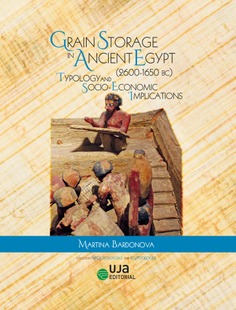
Cómo citar este libro
Bardonova, Martina. (2023). Grain Storage in Ancient Egypt (2600-1650 BC). Typology and socio-economic implications. Universidad de Jaén. UJA Editorial
Comprar en librerías
Grain Storage in Ancient Egypt (2600-1650 BC). Typology and socio-economic implications
Martina Bardonova
The present book deals with the complex subject of the Grain storage in ancient Egypt during earlier historical eras (2600-1650 BC). It comprises the typology of contemporary storage structures and the study of storage practices and their relations to the socio-economic and political changes taking place in the given era.
- Autor/a
- Martina Bardonova
- Colección
- Arqueologías. Serie Egiptología
- Idioma
- English
- Editorial
- UJA Editorial
- EAN
- 9788491595656
- ISBN
- 978-84-9159-565-6
- Páginas
- 440
- Ancho
- 19 cm
- Alto
- 25 cm
- Edición
- 1
- Fecha publicación
- 31-12-2023
- Número en la colección
- 5
Sobre Martina Bardonova (Autor/a)
Contenidos
I. INTRODUCTION
1. What is the grain storage and how to study it?
PART 1. THE CORPUS
II. GRAIN STORAGE IN THE ARCHAEOLOGICAL EVIDENCE
1. Cereals grown between the Old and the Middle Kindom
2. Storage facilities and containers
2.1. Type 1: Circular storage facilities
2.2. Type 2: Orthogonal structures
2.3. Type 3: Magazines
2.4. Type 4 and 5: pits and containers
2.5. Invisible silos?
3. Concluding remarks
III. ICONOGRAPHY OF THE GRAIN STORAGE
1. Cereals in contemporary images
2. The two-dimensional images of storage facilities
2.1. Type 1 (circular silos)
2.2. Type 2 (orthogonal, vaulted)
2.3. Type 3 (orthogonal)
2.4. Evolution of other components
3. The two-dimensional images of storage facilities and their accompanying labels
4. The three-dimensional images of storage facilities
4.1. Type M1 (individual silos and models composed of rows of circular silos)
4.2. Type M2 (orthogonal storage structures)
5. Type 4 (containers)
5.1. Type 4A (pottery containers)
5.2. Type 4B (bags, sacks and baskets)
6. Concluding remarks
IV. GRAIN STORAGE IN WRITTEN SOURCES
1. Contemporary terms referring to cereals
1.1. J.t
1.2. B8.6
1.3. 4w.t
1.4. PxA
1.5. 4Sr
1.6. BSA
1.7. 4X.t (sS.t)
2. Contemporary terms referring to built-up storage facilities
2.1. 5nw.t
2.2. Mxr/mXr
2.3. 5Aa
2.4. 5na
2.5. WDA
2.6. 2tm
2.7. 5na, wDA and xtm identification
3. Contemporary terms referring to containers
3.1. 5d
3.2. 3Ar
3.3. 4TA(.t)
3.4. 8mA
4. Concluding remarks
PART 2. socio-economic implications of tHe attested storage practices
V. GRAIN STORAGE FACILITIES: SOCIO-ECONOMIC MODELS AND THE ORGANIZATION OF AGRICULTURAL PRODUCTION
5. Organization of agricultural production
5.1. Evidence
5.2. Patrimonial Household Model
5.3. Rural landscape
6. Old Kingdom sites
6.1. Old Kingdom Elephantine
6.2. Dakhla Oasis
6.3. Dahshur
6.4. Abu Rawash
6.5. Giza
6.6. Abusir
6.7. Saqqara
6.8. Pyramid towns, the summary
6.9. Old Kindom sites, concluding remarks
7. First Intermediate Period and Middle Kingdom sites
7.1. Middle Kingdom Elephantine
7.2. Abydos North and Abu Ghalib
7.3. Tell ed-Daba FI (13th Dynasty) and Memphis
7.4. Ezbet Rushdi
7.5. Middle Kingdom household producers, the Summary
7.6. Lahun
7.7. Other individual subjects
7.8. Nubian fortresses: Case of Askut and Uronarti
7.9. The Middle Kindom storage practices in comparison to those of the Old Kindom
V. GRAIN STORAGE BETWEEN THE OLD AND THE MIDDLE KINDOM, CONCLUDING REMARKS
BIBLIOGRAPHY
Abbreviations
INTERNET RESOURCES
ANNEX (THE CATALOGUE)
Libros relacionados
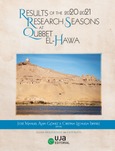
Results of the 2020-2021: Research Seasons at Qubbet el-Hawa
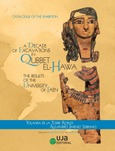
A Decade of Excavations in Qubbet el-Hawa: The Results of the University of Jaén: Catalogue of the Exhibition
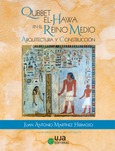
Qubbet el-Hawa en el Reino Medio: Arquitectura y Construcción
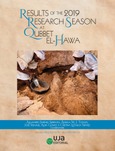
Results of the 2019 Research Season at Qubbet el-Hawa

España en la campaña de salvamento de la Unesco en Nubia: 1960-1972


 Unebook
Unebook  Todos tus libros
Todos tus libros  Casa del libro
Casa del libro 
